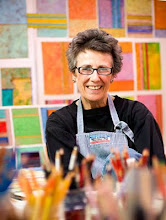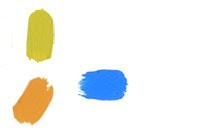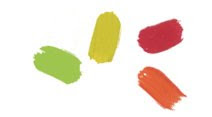We used oil paints in the painting studio at school in the fifties. The acrylic paints I choose to use now don’t have the delicious smell or buttery feel or the depth and opulence of oil paint. Neither are they accompanied by the fumes of the turpentine that we used back then to thin our paint and clean our brushes. There are some fume-less, odorless thinners now and more variety of oils than the single linseed we used back then and some other interesting additions to what the painter can use to manage the look, drying time and toxicity of her materials. But mostly, oil painting now is very much like what it was during the time of Rembrandt and many artists appreciate that connection to the past and the tradition, to say nothing of being hooked on the feel of the paint.
Acrylics are still being developed intensively and have evolved into an amazingly versatile medium. Does anybody remember a comic strip called Li’l Abner? There was a character called the Shmoo, shaped like a soft bowling pin. See what one looks like at Wikipedia. “Shmoos are delicious to eat, and are eager to be eaten. If a human looks at one hungrily, it will happily immolate itself, either by jumping into a frying pan, after which they taste like chicken, or into a broiling pan, after which they taste like steak. When roasted they taste like pork, and when baked they taste like catfish. (Raw, they taste like oysters on the half-shell.)”
Acrylics are like the shmoo. They can look be made to look like watercolor, oil paint, gouache or encaustic. There are additives to build texture, to adjust drying time, mediums to change the viscosity and make transparent glazes, extend the paint and more materials of assistance to the artist than can be listed here. Acrylics are fast drying allowing the creator to layer his paint, make corrections and zip along without delay. The thicker mediums are good for adhering collage elements. Acrylics can be applied to an almost any kind of surface. We never had it so good.
Today facts and instruction about paints, painting and every kind of artist material and medium and process are available in the form of books, workshops, tutorials on disk and on the web. There is a wealth of information about techniques unknown to us as students, and directions for making little miracles happen with modern and traditional materials that are ours for the taking. One would have to be cloned several times over to examine it all.
I still miss the fragrance of oil paint. I brought home the still wet paintings I was working on at school — on the subway, no less. My bedroom was tiny; there was a bed, a dresser and a night table and some awful teen-age messiness plus a fairly large drawing table and a pretty big easel. My father would storm into my room at night shouting “Are you trying to kill yourself?” and he would open my windows. I didn’t want to let the cold in and I didn’t notice the fumes. The plants on my windowsill withered but I survived to paint another day.
The image above is a giclee of Structures, 2008, 8.5 x 11". For information about any of the paintings seen on this site please email Joan.














Hi, Joan. I really like posts like this one because it opens a window into an artist's studio for those of us who are art lovers, but not practitioners (I mean I can't even write my name legibly, let alone paint or draw). You conjure up the smell and texture of the painter's work materials very nicely.
ReplyDeleteLove the anecdote about the oil paintings in your room. I can just imagine your dad flinging the window open.